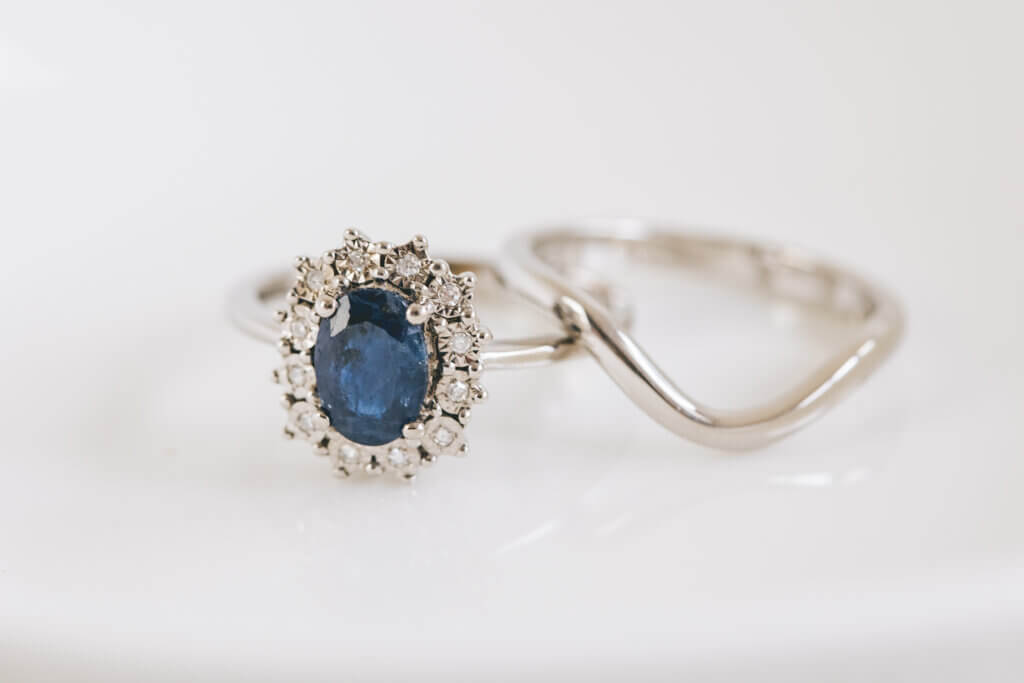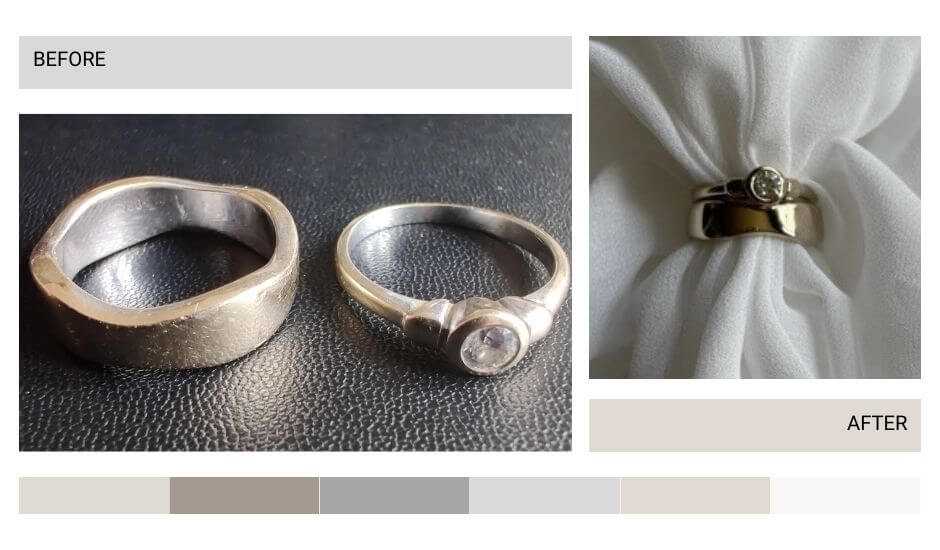You’ve got a new beautiful white gold ring you have worn for a few months, but then you notice the metal around the back of the ring and the setting have changed colour. Patches of your ring are a totally different shade of white, and next to the bright silvery areas that remain, these patches almost look yellow. Is your ring tarnishing?

Gold does not tarnish*
What people might believe is tarnish on their white gold jewellery is actually the natural colour of the white gold coming through. The vast majority of white gold jewellery is rhodium-plated to make it look a bright, cold white like platinum, but this plating is only microns thick so will wear over time, revealing the natural warmer tones of the white gold. This usually happens in patches, for example, on a ring, the back of the ring and any settings will wear first as they come under the most wear and tear through everyday life.
Therefore any colour change is not tarnish, but the true colour of the white gold showing through the plating in patches. Next to the bright, cool white of rhodium, these patches will look more yellow than they really are.
Why doesn’t gold tarnish?
One of the reasons gold is used in jewellery is because it is one of the least reactive elements, meaning it does not react to oxygen, moisture or sulphur. Other metals such as copper and silver are much more reactive and will tarnish and discolour over time. For most people, the oils in our skin stop silver from tarnishing when worn, but leave a silver ring in a bathroom for a while unworn and it will soon turn black from being exposed to moisture.
Pure 24ct gold is too soft to use in jewellery so it is blended with other alloys to firstly make it more durable, but also to change the colour. White gold is created by mixing pure gold which is yellow with white coloured alloys such as silver and platinum to lighten the yellow hue and almost bleach the yellow colour. Rose gold has a high copper content, and these other alloys will tarnish, and therefore *a gold piece of jewellery left unworn in a jewellery box for decades will show some areas of tarnish. This is not due to the gold itself, but the other alloys in the mix.
If you’re interested in finding out more about white gold, you can learn more here.
Why is white gold rhodium plated?
White gold does not need to be plated, and I am a big advocate for avoiding plating white gold and embracing its natural, warm colour. Many years ago, white gold was plated because it had alloys in it that some people have allergic reactions to (namely nickel). White gold was therefore plated with rhodium (another almost inert chemical element) to give a protective coating between the jewellery and the wearer’s skin to avoid causing a reaction. Nickel is no longer used in jewellery alloys in the UK so this reason is null and void.
You can read in more detail about the plating process and my argument for why I believe white gold should not be plated here.
What are my options once the rhodium plating starts to rub off?
Over time, if left, all of the plating will wear away from a piece of white gold to reveal the natural colour. Your options are:
- Go au natural and embrace the natural colour – have your rings cleaned and polished up and they will be bright, shiny and beautifully white, just a slightly warmer tone of white than they were originally! White stones like diamonds stand out more in natural white gold because the colours contrast, whereas diamonds set in platinum or rhodium plated white gold give an all over sparkle as they are similar in hue. If you like this look, let the white gold shine in its natural glory. The warmer tone might even suit your skin tone better! The beautiful ring below is 9ct white gold set with a white diamond – notice how the diamond is a different tone of white so it stands out nicely from the metal of the setting.

- Have your ring re-plated every now and then. Each person’s experience will vary with how long it takes for the rhodium plating to wear away and need re-doing but each time you want it brought back to bright white, you will need to hand your ring back to your jeweller and they will re-polish it and plate it. It’s worth bearing in mind that polishing actually removes material from your jewellery so you will thin out your pieces more quickly if they are regularly re-polished. The plating process is a nasty one that uses horrible chemicals so it will have an environmental impact too. Cost wise, over the years you will most likely spend more in total on re-plating than purchasing platinum rings in the first case.

- Have your jewellery remade in palladium or platinum if you prefer the bright white colour – you can usually reuse your stones and the design could be exactly replicated. You can sell the white gold as scrap to off-set the cost.

There is so much confusion surrounding white gold but I hope this post helps shed some light on the mystery of tarnishing. If you’ve got any experience with white gold either being rhodium plated or in its natural colour, I’d love to hear your thoughts in the comments section below.
Alternatively, if you’re in the market for a bespoke jewellery design, do consider getting in touch. I work closely with my clients to design bespoke wedding rings, bespoke engagement rings and much more.


13 Comments on “Why is my white gold tarnishing?”
I bought a ring from eBay a wedding band supposed to be 10 carrot white gold it’s like gold with small diamonds in it or something but the gold on the inside is turning black and the 10K parts scratched off and I’m trying to figure out why even reading your article I still don’t understand what the reason really is if you could email me your AJMK10255 yahoo.com thank you
Hi, I’m sorry to hear you’ve had this experience – it sounds like it is not genuine unfortunately. Real gold does not tarnish. Perhaps it is 10ct plated and the plating has worn away? Hopefully the seller on ebay can shed some light on it. I hope you get it resolved!
Tremendeous blog! Thanks for sharing it 🙂
Actually Gold does tarnish, it just takes a lifetime or more. If you have ever opened up a jewelry box that was in storage and unused for 50+ years you will see a gentle tarnish on gold items, its easy to polish off. Its also depends on what was used for the alloys. 🙂
Yes you’re right – but with everyday wear, it won’t oxidise
This article is a very informative and helpful guide on why white gold tarnishes and how to prevent it. I learned a lot from reading the article, such as the difference between white gold and platinum, the role of rhodium plating, and the tips on how to care for white gold jewellery. The article was well-written, clear, and engaging. I appreciate the author’s expertise and passion for jewellery. Thank you for sharing this excellent article! 😊
Thanks Boka!
Hi, i bought an 18 carat white gold with a diamond center stone from damas jewellery for my fiancé, however, it was only 2 months ago when i bought it and the colour has already started to change to yellowish from the bottom, what i want to know, is that is the timing normal or it should take longer for the colour to change
Hi Houssem,
The rhodium can fade quite quickly depending on how thickly applied the rhodium is and how much wear it gets – everyone is different but two months does seem very short! The colour will look yellowy next to the remaining rhodium but if it was to be polished off, the colour would appear much more white.
I hope this helps!
Is there something that can just remove the palladium completely? Also, thanks so much for the article, it’s extremely helpful.
I am glad you found it useful 🙂 it can easily be polished off by a goldsmith to bring back the natural colour of the gold.
In 1977 I purchased a white gold class ring fron Johnstons which tarnished very quickly. I’m almost sure the ring I recieved was not white gold.
I’m sorry to hear this!